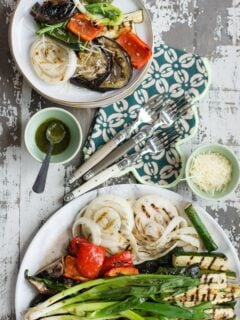This restaurant-style Ahi Tuna Sushi Bowl recipe is a smorgasbord of healthy, fresh ingredients. Beautiful, flavorful, and good for your body!

Easy, Gourmet Sushi Bowls You Can Make in Your Own Kitchen!
I love all things sushi – it’s one of my favorite things to go out for. What about you? But I have to confess, I rarely make my own sushi at home. This sushi bowl recipe is a game-changer, though. It brings together all of the best sushi flavors into one easy-to-make, easy-to-eat dinner dish.
I think this recipe would be fantastic for a fun date night, maybe with a good movie and some great beer (or sake!). You could also serve it as a super-healthy dinner for anyone who’s trying to watch their diet. For those going low carb, feel free to leave out the rice. There’s still lots to love, here!
(Want more bowls of goodness? Check out this Asian Beef Rainbow Salad, or my Vietnamese Shrimp Edamame Salad!)

Do You Eat Sushi Bowls Hot or Cold?
A sushi bowl is like regular sushi, just deconstructed and served more like a big salad of ingredients. That said, you could totally make a warm or hot sushi bowl, using warm or hot ingredients. However, it’s probably more common to eat sushi bowls at room temperature, or cold. This one is basically served at room temperature, with seared tuna that’s had a couple of minutes to sit before slicing.
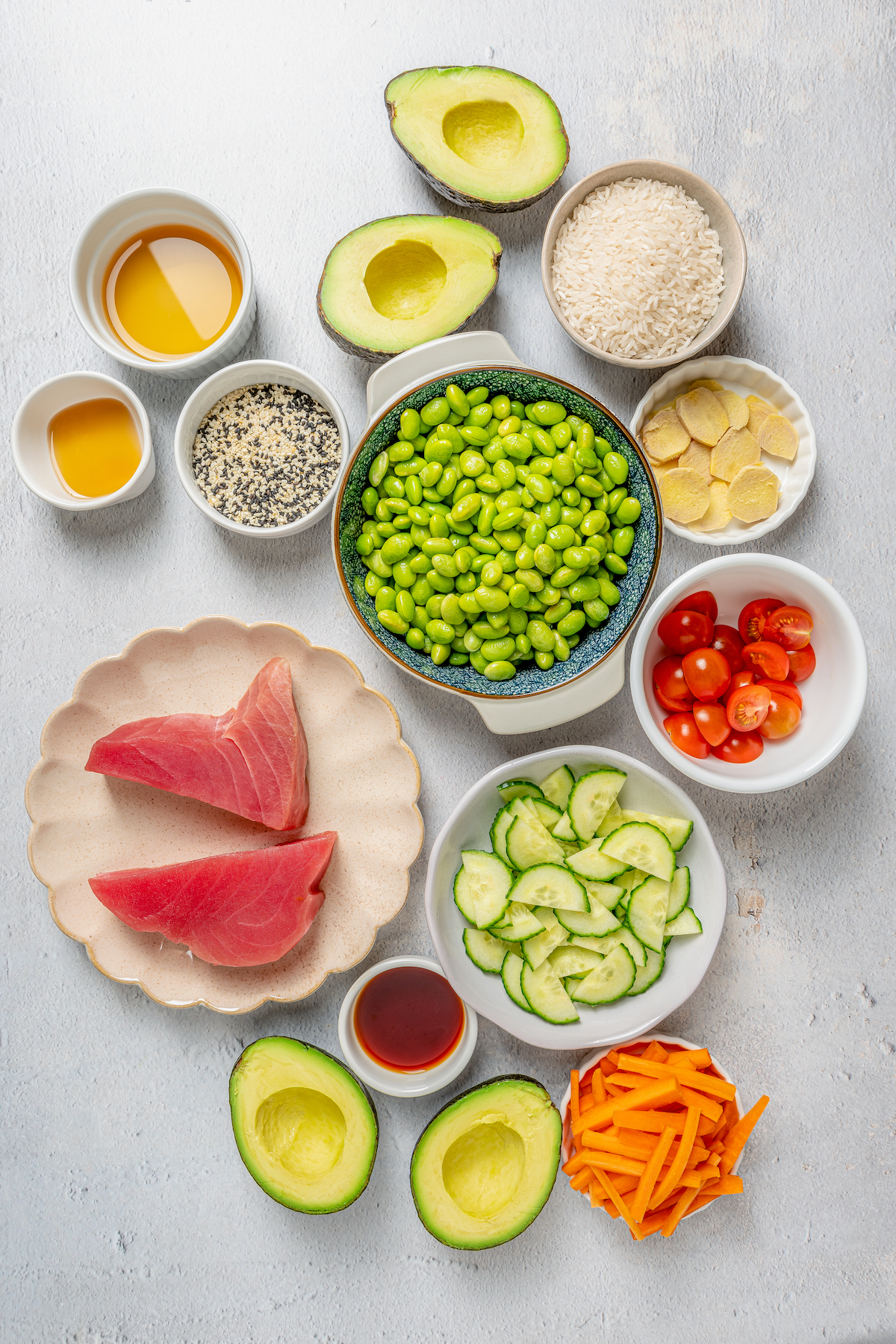
The Ingredients
I should probably warn you: just reading through this ingredient list is enough to make you hungry! Each item packs a punch of flavor and texture. Here’s what you will need to make these amazing sushi bowls:
- Ginger: Choose a straight piece that is quite slim, and peel away the outer layer.
- Apple Cider Vinegar: I like raw apple cider vinegar.
- Rice: Plain white rice, or you can use sushi rice if you have it.
- Edamame: For me, these are easiest to find frozen. You could definitely use fresh ones if you have them!
- Tamari: Or soy sauce, or coconut aminos.
- Avocados: Slice up the avocado into thin pieces.
- Carrots: Cut into matchsticks, or you can just grate the carrot with a box grater.
- Cherry Tomatoes: Cut in half. Grape tomatoes would also be great.
- Cucumber: Slice the cucumber thinly. You can scoop out the seeds with a spoon, or leave them in – whichever you like.
- Sesame Oil and Sesame Seeds: I prefer the sesame seeds toasted, to bring out the flavors even more. Untoasted sesame seeds are fine, too.
- Ahi Tuna: Make sure to get good-quality tuna from a reputable seller.

Why Is Ahi Tuna Special?
“Ahi” is the Hawaiian term for two kinds of tuna, yellowfin and bigeye. Both are lean, flavorful, and perfect for all kinds of recipes from sushi to sashimi to grilling. It’s usually cooked rare or medium-rare, which is what this recipe calls for as well. This healthy protein option is a great way to get seafood into your diet. It’s rich in Omega-3 fatty acids, B vitamins, selenium, and more.

How to Make This Ahi Tuna Sushi Bowl
- Prep the Tuna: Set the tuna out on the counter, covered, for about twenty minutes before you cook it, so it can come up closer to room temperature. Then pat it dry, and sprinkle it generously with salt and pepper on both sides.
- Sear the Tuna. Next, heat the oil in a skillet over medium-high heat. Add the tuna steak, and cook it for just a minute or two per side, until the fish is lightly browned on the outside but still rare on the inside. Take it out of the skillet and let it cool on a clean plate before slicing it and adding it to the sushi bowl.

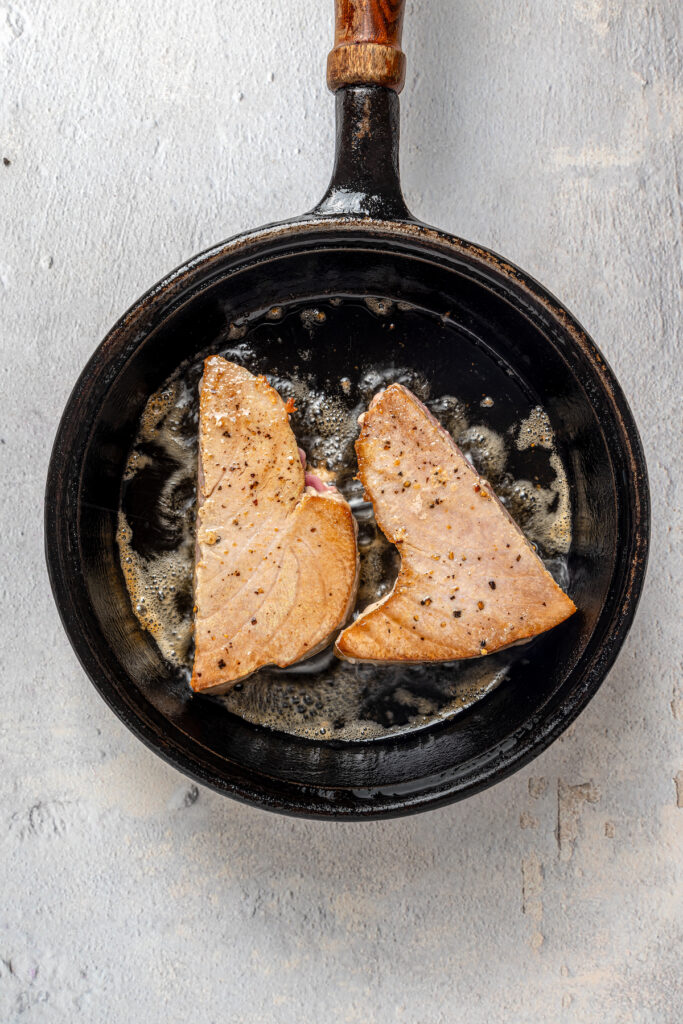
- Prep the Ginger. Cut the ginger as thinly as you can, making wafer-thin slices (or just finely grate/shred it). Put the ginger in a bowl with the vinegar and a splash of water, and massage the pieces briefly to soften them up. Set aside.
- Make the Rice and Edamame. Put the rice in a medium saucepan and add about two and a half cups of water. Bring the rice to a boil, cover the saucepan, and simmer on low for 15 minutes. Then sprinkle the edamame on top, but don’t stir it in. Cover with the lid, and let everything cook for another seven minutes. At that point, the rice should be tender and the water should all be absorbed.

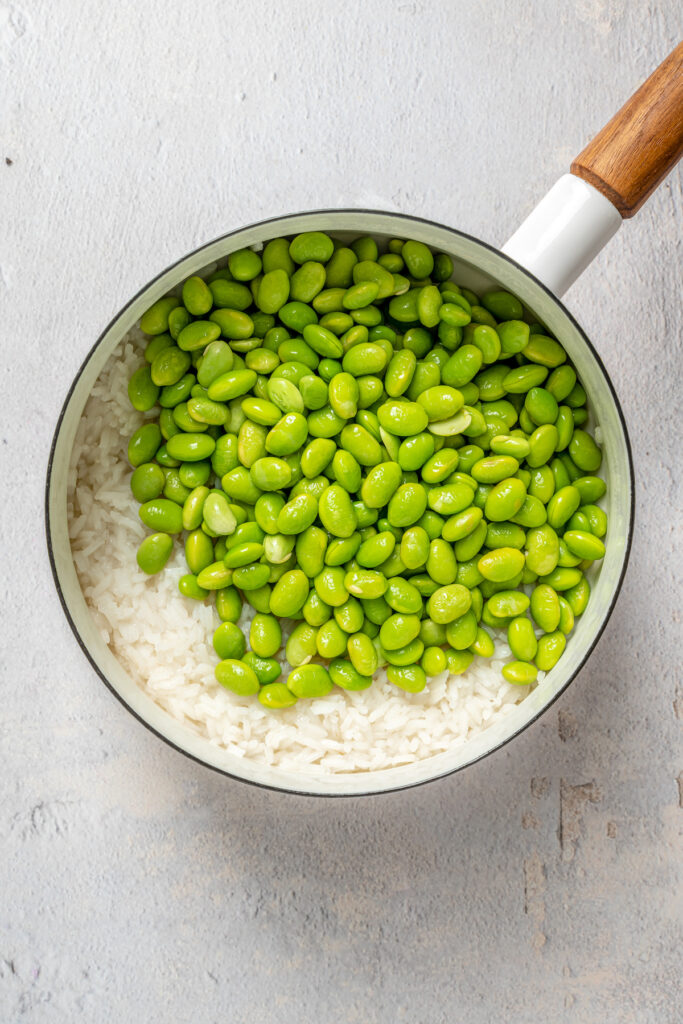
- Assemble the Bowls. Scoop the edamame off the top of the rice, and set aside. Add a splash of vinegar and tamari to the rice, and stir well. Spoon the rice onto a clean plate, and spread it out in a thin layer to cool off. Once the rice has cooled, divide it into four bowls. Top each bowl with avocado, carrots, edamame, tomatoes, and cucumber.
- Add Ginger, Dressing, and Sesame Seeds. Take the ginger pieces out of the vinegar, and scatter them over each bowl. Add some tamari and sesame oil to the vinegar in the bowl, and stir well to make a dressing. Drizzle this over the sushi bowls, and then sprinkle each one with the toasted sesame seeds.
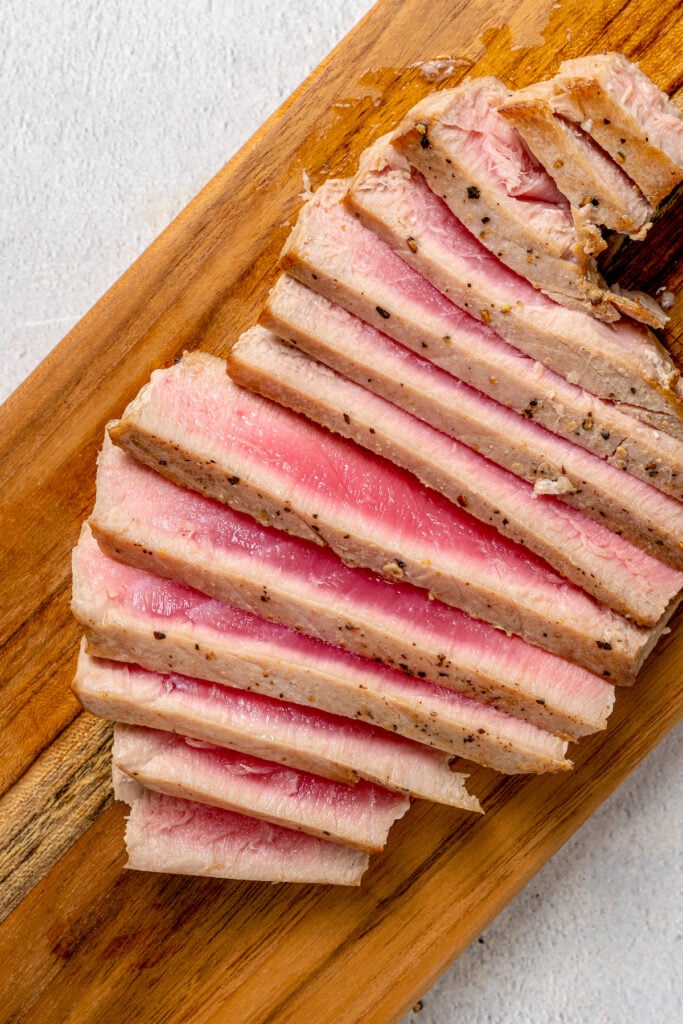
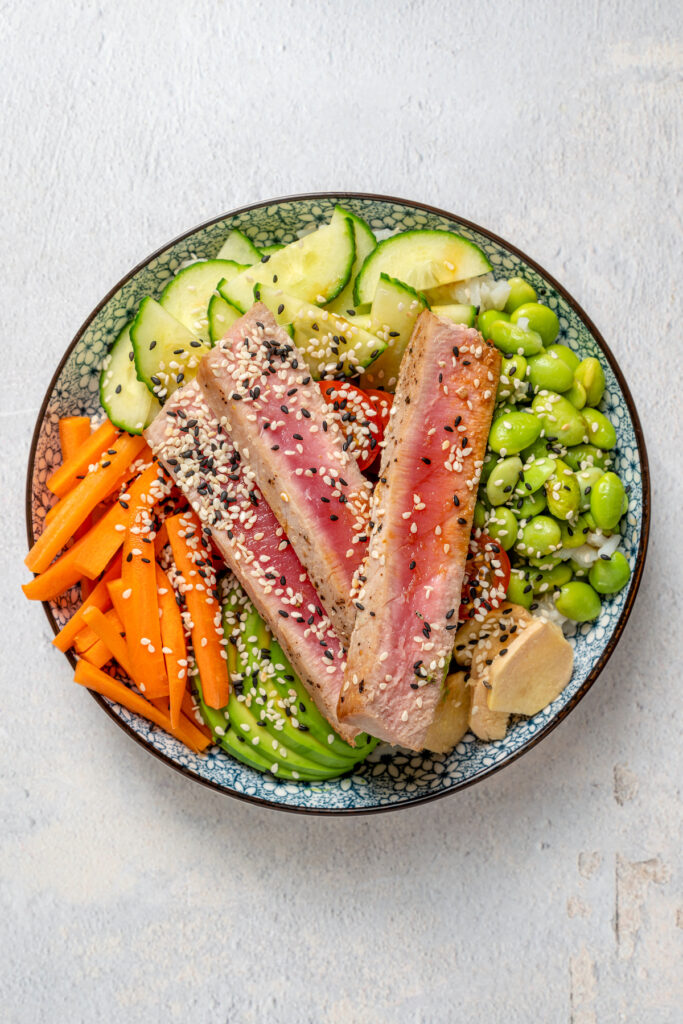
Helpful Tips
Before you start getting all of your ingredients together, I hope you’ll take a minute or two to read over these tips for sushi bowl success. Here’s what I’ve learned about making seared Ahi tuna bowls:
- Can I Use Frozen Tuna? It’s totally fine to use frozen tuna in this recipe. In fact, frozen seafood is often better quality than fresh seafood, unless you can get super-fresh, unfrozen seafood the same day it was caught. Most of us don’t have that option! Thankfully, frozen seafood is usually caught, cleaned, and quickly flash-frozen, preserving all of those nutrients and flavors until it’s time to thaw it out and cook it. Just be sure to thaw in advance.
- Tuna Doneness: For a medium-rare tuna steak, the internal temperature should be 130°F. Check the tuna with a food thermometer at the thickest point, and remember that it will continue cooking a little bit while sitting.
- Bowl Toppings: Feel free to play around with the toppings in this dish, adding your favorites and leaving out those you don’t care for.
- Dressing: While the simple dressing of ginger-infused vinegar, tamari, and sesame oil is a nice complement to the other flavors in the bowl, you can substitute any dressing or sauce that you would normally use with sushi, such as wasabi and soy sauce, spicy mayonnaise, eel sauce, etc.

What Goes with Sushi Bowls?
This bowl is a meal in itself, but it also pairs well with your favorite veggie side dishes. These are just a few you can try!
- Bok Choy: For a serving of greens, you can’t go wrong with making some Roasted Bok Choy! You’ll love how this mild, yet tasty veggie shows off its flavors when roasted.
- Asparagus: When it’s asparagus season, you basically have to bring home a bouquet of these yummy green spears. And this recipe for Sesame Roasted Asparagus turns them into the perfect side dish to go with sushi bowls. Hey, I don’t make the rules!
- Grilled Vegetable Plate: This easy combo of fresh vegetables, thrown on the grill and seasoned, makes a good side dish with almost any meal. Plus, a Grilled Vegetable Plate is super customizable.
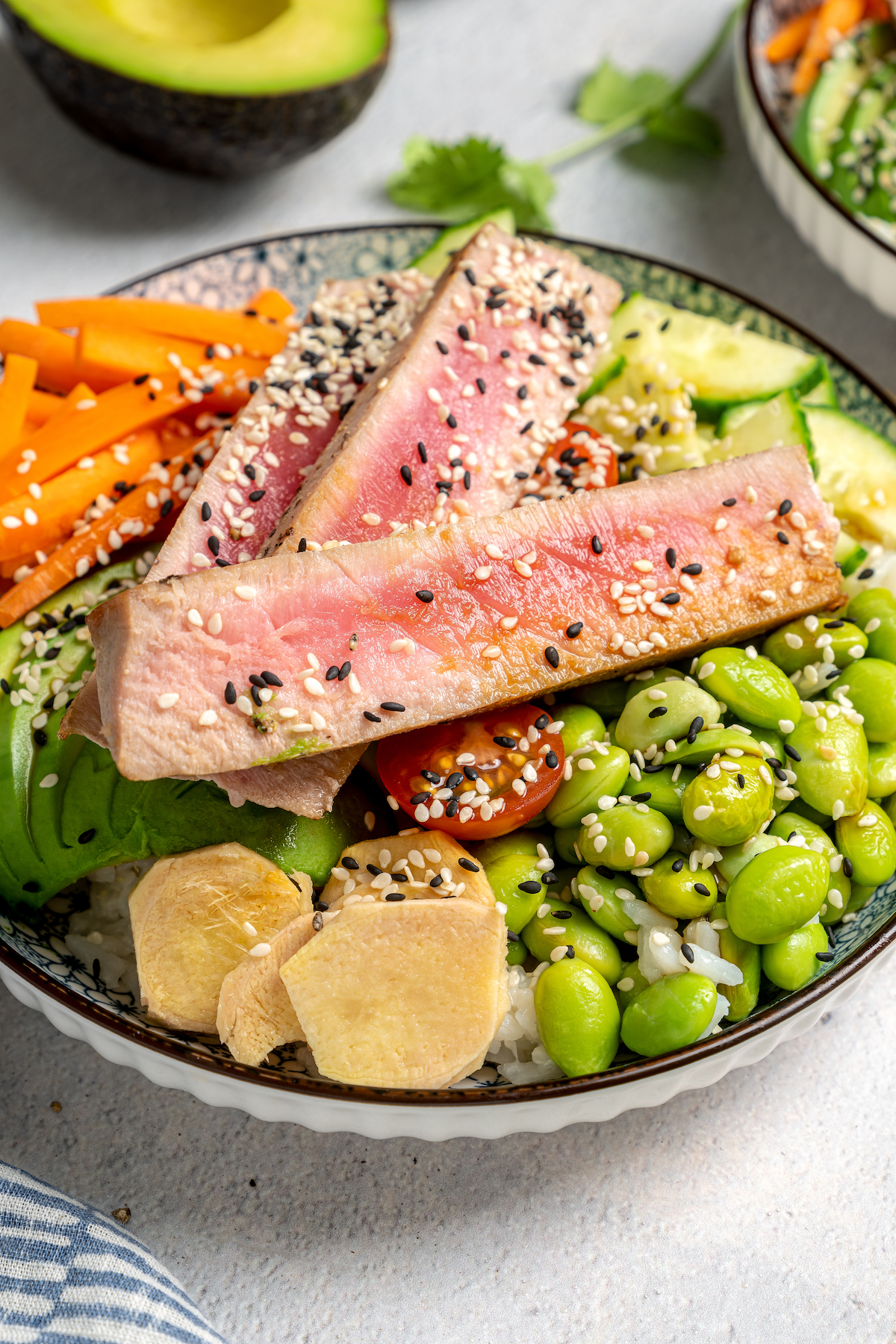
Storing the Leftovers
You can store this sushi bowl recipe in the fridge for up to 2 days. For the longest storage time, I recommend storing each ingredient separately, in airtight containers. If you store the entire sushi bowl, I recommend using it within 24 hours for the best taste and texture.

Ahi Tuna Sushi Bowl
Ingredients
- .8 ounce ginger choose a straight, slim piece peeled
- 5 tablespoons raw apple cider vinegar divided
- 7 ounces white rice
- 11 ounces edamame beans frozen
- 2 tablespoons tamari
- 2 avocados pitted and sliced
- 1 large carrot shredded into long matchsticks or coarsely grated
- 1.5 ounces cherry tomatoes halved
- ¼ cucumber sliced
- 2 teaspoons sesame oil
- 3 tablespoons toasted sesame seeds
- 12 ounces Ahi tuna
Instructions
- Allow the tuna steak to come to room temperature by letting it stand for at least 20 minutes.
- Pat the tuna dry. Sprinkle liberally with kosher salt and fresh ground black pepper on both sides.
- Heat the oil in a medium skillet over medium high heat. Add the steak and cook 1 to 2 minutes per side, until lightly browned on the outside but still rare on the inside. The tuna will continue cooking while sitting.
- For a medium-rare tuna steak, the internal temperature should be 130°F when measured with a food thermometer at the thickest point.
- Cool for 2 minutes. Then slice the tuna against the grain into ½-inch slices and serve immediately.
- Cut the ginger as thinly as you can to make wafer-thin slices or finely shred. Put in a bowl with the 4 tablespoons vinegar and 1 tablespoon water. Massage briefly to soften. Set aside.
- Put the rice in a medium saucepan and add 2 ½ cups of water. Bring to a boil, cover, and simmer on low heat for 15 minutes. Sprinkle in the edamame, but don’t stir them in. Cover and cook for 7 minutes more. The rice should be tender and have absorbed all the water.
- Skim the edamame off of the top of the rice, and set aside.
- Add 1 tablespoon of vinegar and ½ – 1 tablespoon tamari into the rice, and stir well. Spoon onto a plate and spread out to cool quickly. Once cool, spoon into four bowls.
- Top each bowl with the avocado, carrot, edamame, tomatoes and cucumber.
- Spoon the ginger from the vinegar and scatter on top of the bowls. Add the remaining tamari and sesame oil to the vinegar. Spoon over the sushi bowlsl and top with sesame seeds.
Notes
- Can I Use Frozen Tuna? It’s totally fine to use frozen tuna in this recipe. In fact, frozen seafood is often better quality than fresh seafood, unless you can get super-fresh, unfrozen seafood the same day it was caught. Most of us don’t have that option! Thankfully, frozen seafood is usually caught, cleaned, and quickly flash-frozen, preserving all of those nutrients and flavors until it’s time to thaw it out and cook it. Just be sure to thaw in advance.
- Tuna Doneness: For a medium-rare tuna steak, the internal temperature should be 130°F. Check the tuna with a food thermometer at the thickest point, and remember that it will continue cooking a little bit while sitting.
- Bowl Toppings: Feel free to play around with the toppings in this dish, adding your favorites and leaving out those you don’t care for.
- Dressing: While the simple dressing of ginger-infused vinegar, tamari, and sesame oil is a nice complement to the other flavors in the bowl, you can substitute any dressing or sauce that you would normally use with sushi, such as wasabi and soy sauce, spicy mayonnaise, eel sauce, etc.
- Storage: Ahi tuna sushi bowls will keep, tightly covered, in the refrigerator for up to two days.








